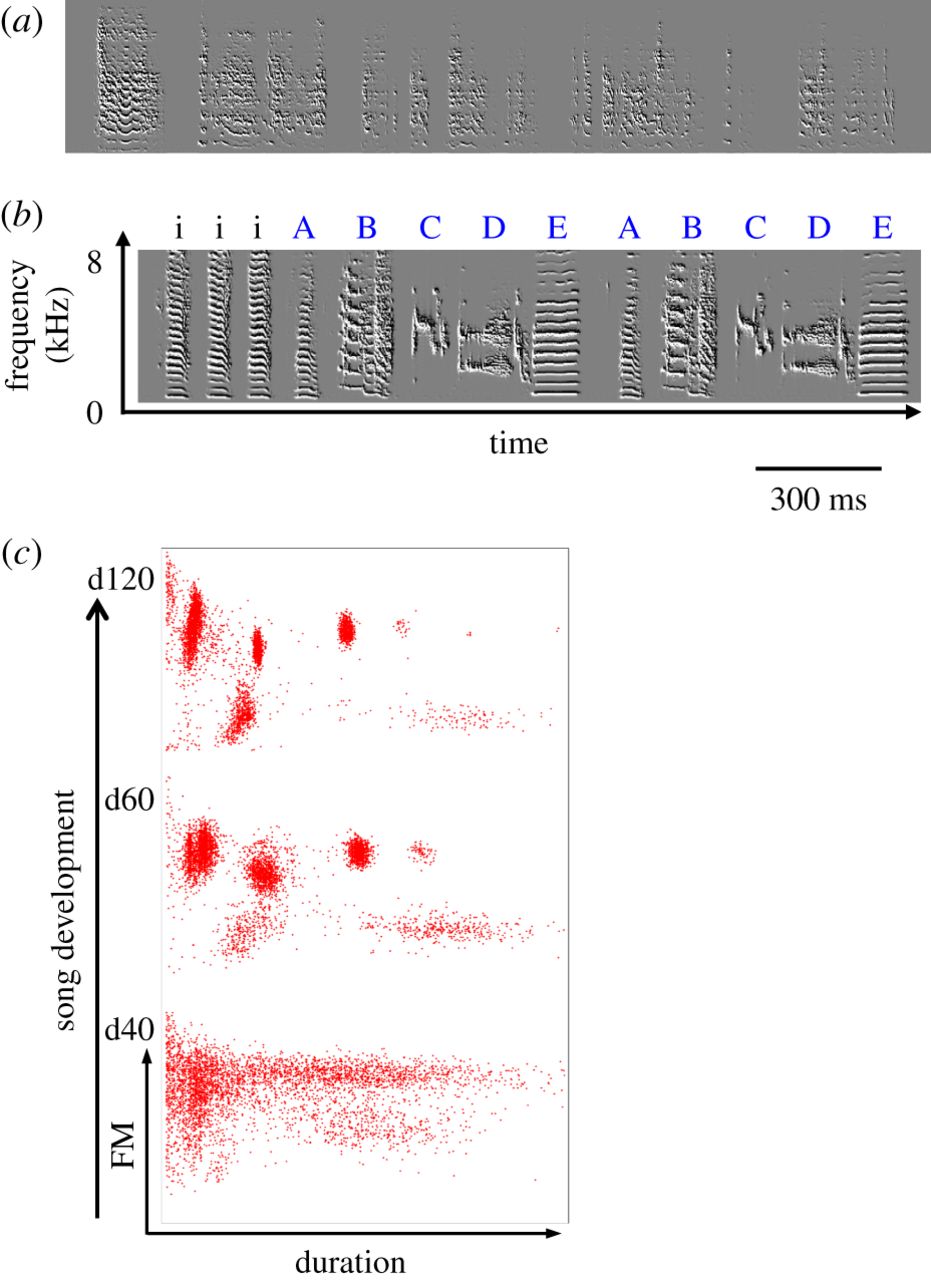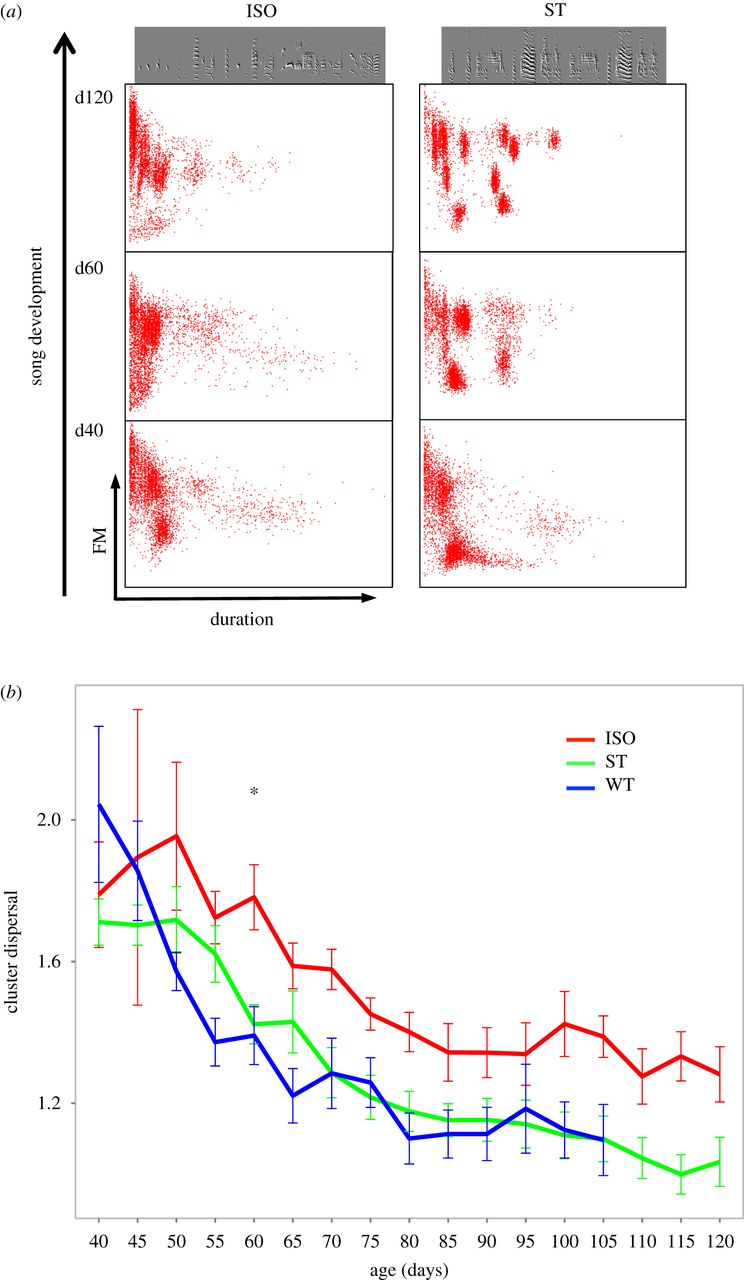Zebra finch self-tutoring
« previous post | next post »
Sometimes a new experimental result suggests a very different way of interpreting older results. On a visit a couple of days ago to Ofer Tchernichovski's lab at Hunter College, I encountered a striking example of this effect.
The background is the experimental literature on zebra finch song learning. If one of these birds is raised in acoustic and social isolation, it never learns to sing a species-typical song, but rather continues to produce "proto-song", which is a sort of songbird equivalent of grunts and groans. In contrast, with a relatively brief exposure to an example of adult song during a "critical period" early in life, a bird will (later on) learn to sing properly, in fact imitating the tutor's song quite closely. Crucially, species-typical zebra finch song is made up of discrete "syllables" arranged in regular "motifs", whereas proto-song is relatively diffuse and non-categorical at all time scales.
A decade ago, I reported on some fascinating work from Ofer's lab showing that species-typical song can emerge over a few generations in a colony raised in acoustic isolation, never encountering any external adult models ("Creole birdsong?" 5/9/2008).
Now a newer experiment (Olga Fehér et al., "Statistical learning in songbirds: from self-tutoring to song culture", Phil. Trans. R. Soc. B 2016) adds a result that makes us think differently about the earlier work.
The punch line: a zebra finch raised in acoustic and social isolation, with "tutoring" by playback of its own vocalizations from a few moments before, acquires species-typical song in just about the same way as a bird raised with exposure to a "wild type" adult model.
Here are some illustrative figures from the paper — the categories are
- WT = "Wild Type", birds raised with "exposure to song playbacks that approximate the natural, categorical song input";
- ISO = birds raised in "social and acoustic isolation";
- ST = "self-tutored" birds, who are given "playbacks of their own developing song, which is initially non-categorical".
Figure 1 shows the pattern of development for a bird exposed to an adult model during its critical period:
Caption: Transition from continuous to categorical signal over development. (a) Sonogram of a juvenile zebra finch (day 40) showing highly variable, undifferentiated syllables. (b) Adult song of the same zebra finch showing stable syllable types falling into distinct categories. Introductory syllables are denoted by i; letters stand for song syllables that are repeated in a fixed order (ABCDE…). (c) Development of syllable types (categorical signal) in a WT bird. Dots represent song syllables: mean frequency modulation (y axis) is plotted against syllable duration (x axis, both normalized). Bottom panel represents distribution of syllables at the subsong stage, top panel at adulthood.
Fig. 4 compares the developmental patterns for ISO and ST birds:
Caption: Syllables form tight clusters in WT and ST birds but not in ISOs. (a) Cluster formation in an ISO bird (left column), his ST brother (right column). Dots represent song syllables: mean frequency modulation is plotted against syllable duration (both normalized). The top panels represent adult songs, the bottom ones the beginning of development, and the middle row a stage in early development when ST birds have already begun to produce stable and tightly clustered syllables not present in ISOs. (b) Median Euclidean distance between neighbouring syllables. Over song ontogeny, syllables of the same type become more similar in every group, but this happens faster and earlier in self- and WT birds while the ISOs never form tight clusters.
Here are some examples (from other sources) of what proto-song and species-typical mature song sound like. The top row is a song bout at normal speed; the bottom row present the same material slowed down by a factor of four:
| Proto-song | Mature song | ||
| Normal | |||
| Slow |
Some earlier birdsong posts:
"Emergence of birdsong phonology", 10/11/2003
"Birdsong and speech: together in the genome?", 4/7/2004
"Watch out for those Wallonian finches", 5/22/2007
"Dialect variation in the terminal flourishes of Flemish chaffinches", 5/27/2007
"Finches again", 6/9/2007
"Finch phrase structure?", 10/1/2007
"Creole birdsong?", 5/9/2008
"A multi-generational bioprogram? Derek Bickerton objects", 5/10/2008
"What's in a generation or two?", 5/12/2008
"Musical protolanguage: Darwin's theory of language evolution revisited", 2/12/2009
"Bickerton on Fitch", 2/15/2009
"Finch Linguistics", 7/13/2011
"Finch song learning in the news again", 6/30/2013
"Modeling repetitive behavior", 4/15/2015


Brett Reynolds said,
December 24, 2017 @ 8:03 am
"syllable differentiation, regardless of developmental strategy, occurs by the gradual splitting of neuron sequences in the premotor cortical area high vocal centre (HVC) [55]. Interestingly, the HVC shows strong auditory responses to song stimulation [56], but is temporarily unresponsive to song playbacks while the bird is singing [39]. Because in ISOs the only song input is the auditory feedback of the bird's own song, which is simultaneous with singing, the HVC cannot register it. Song learning in zebra finches requires HVC activation while listening to tutored song [38]."
Does anybody know if the analogue is true in humans?
Sarah Creel said,
December 25, 2017 @ 1:39 am
The curious thing to me is why self-song *does* work but proto-song from other untutored youngsters *doesn't* work, at least not for a few generations. Is there something special about the singing yourself and then having a (seemingly-)contingent "response" (which is actually your own recent utterance)? There are certainly good arguments in child language development that contingent responding by caregivers is critical.
Joyce Melton said,
December 25, 2017 @ 7:50 am
That self-turoring works better than same-tutoring may imply a recognition of self.